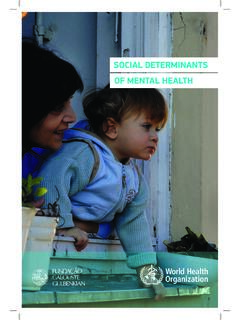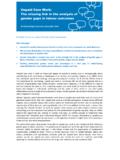Transcription of Gender and Nutrition - Nutrition International
1 Gender and Nutrition Technical Assistance for Nutrition (TAN). Unlike sex, Gender is socially constructed, can vary from society to society, from time to time, and is based on socially acceptable norms and behaviours (1). Addressing Gender in Nutrition is critical; addressing Gender inequalities can result in larger improvements in malnutrition than if Gender inequalities are not tackled. Without addressing the core issue of Gender ( decision making, access to resources, power), we may not make as much progress as is needed to improve Nutrition . Addressing Gender can help put and end to intergenerational malnutrition (2, 3). Hence, as part of TAN's work, it is essential to integrate a Gender lens in the work. This short document provides key messages for discussion with the SUN Focal Point and other key stakeholders. Why does Gender matter to Nutrition ? There are a number of factors that can impact women and children's Nutrition including: Women's ability to influence household decisions The extent women are able to access/control resources for their personal health/well-being (2).
2 Factors that can negatively impact women and children's Nutrition include: The heavy work burden on women A large age difference between the wife and her husband The role of the mother-in-law Polygamous relationships ( children of the wife who is less important (p. 26)). Having no suitable substitute caregivers in families (due to low income/pressure to work). Cultural norms ( around breastfeeding), making it important to engage men and other members of the household ( mother-on-laws) in Nutrition education Gender -based violence (2). On the other hand, factors that can positively impact women and children's Nutrition include: Older maternal age Higher maternal education Women's exposure over their lifetime to paid employment Women's ability to make decisions for domestic purchases and when to seek health care (2). Therefore, it is important to ensure interventions and policies address broader Gender issues.
3 Engaging males is also key to success of Nutrition interventions. Apart from the evidence above, why else should we focus on Gender and Nutrition ? Rationale #1: To Align with the SUN Movement Focus on Gender The SUN Movement has made a commitment to Gender , as one of its 6 priorities in the 2016-2020 strategy: Equity, equality and non-discrimination for all with women and girls at the centre (4, p. 25). The strategy also outlines that: By 2020, all SUN countries will: Have equitable improvement in the Nutrition status of all people, ensuring that no one is left behind Adopt policies that reduce nutritional inequities, especially among women and girls and eliminate discriminatory laws and practices Strive to involve representatives from all communities in their decision-making processes (4, p. 25). Rationale #2: Because Funders are Increasingly Focusing on Gender TAN's funder (the UK Department for International Development) has identified Gender as one of four areas of priority for implementation.
4 Gender is also a key focus for many other funders including Global Affairs Canada; it will be key to integrate Gender into Nutrition work given that funders are interested in this area. Rationale #3: To Align with International Commitments to Gender Most countries have signed on to key International commitments to Gender including: Sustainable Development Goal #5: Gender : Convention on the Elimination of All Forms of Discrimination against Women (CEDAW) (1979): Beijing Declaration and Platform for Action (1995): A Few Key Questions to Start a Conversation on Gender and Nutrition Who has access to resources ( business, property, technology, services)? What are the current knowledge, attitudes and practices about Gender and Nutrition ? What are the cultural norms and beliefs that influence Nutrition ? Who does what in terms of division of labour, household activities? Who controls the decisions in the family and the community?
5 (5, 6). What are the different constraints and opportunities faced by women and men, boys and girls, according to Gender (that relate to Nutrition )? How do Gender relations affect outcomes and the achievement of sustainable results (in Nutrition )? (6). What work is already being done to address the role of men and women in Nutrition ( interventions, policies, plans, guidelines)? What data is already collected on Nutrition that relates to Gender (not just sex-disaggregated data but also data on decision-making, power, access to resources)? Who are the key players working on Gender and Nutrition in the country? Have they been included in discussions? What are the key documents related to Gender and Nutrition in the country? References 1. World Health Organization. Gender 2017 [July 4, 2017]. Available from: rights/understanding/ Gender -definition/e n/. 2. UNICEF and Liverpool School of Tropical Medicine.
6 Gender Influences on Child Survival, Health and Nutrition : A. Narrative Review. New York: UNICEF, 2011. 3. SUN. Guidance Note - 21st SUN Movement Country Network Meeting (14-18 September 2015): Thematic Discussion - Equity and Gender . 2015. 4. SUN. SUN Movement: Strategy and Roadmap (2016-2020). 5. Morgan R, George A, Ssali S, Hawkins K, Molyneux S, Theobald S. How to do (or not to do).. Gender analysis in health systems research. Health Policy Plan. 2016;31(8):1069-78. doi: PubMed PMID: 27117482. 6. Caro D. A Manual for Integrating Gender Into Reproductive Health and HIV Programs: From Commitment to Action (2nd Edition). For the Interagency Gender Working Group; USAID, 2009. This work is supported by Nutrition International , formerly the Micronutrient Initiative, as part of the Technical Assistance for Nutrition (TAN) programme funded with UK. aid from the UK government.

